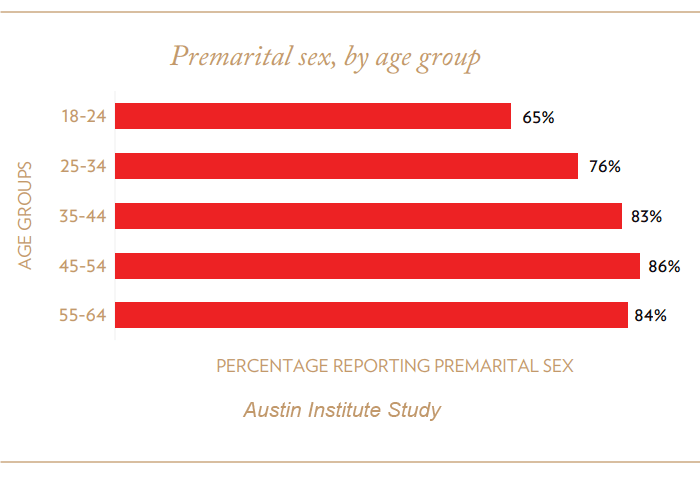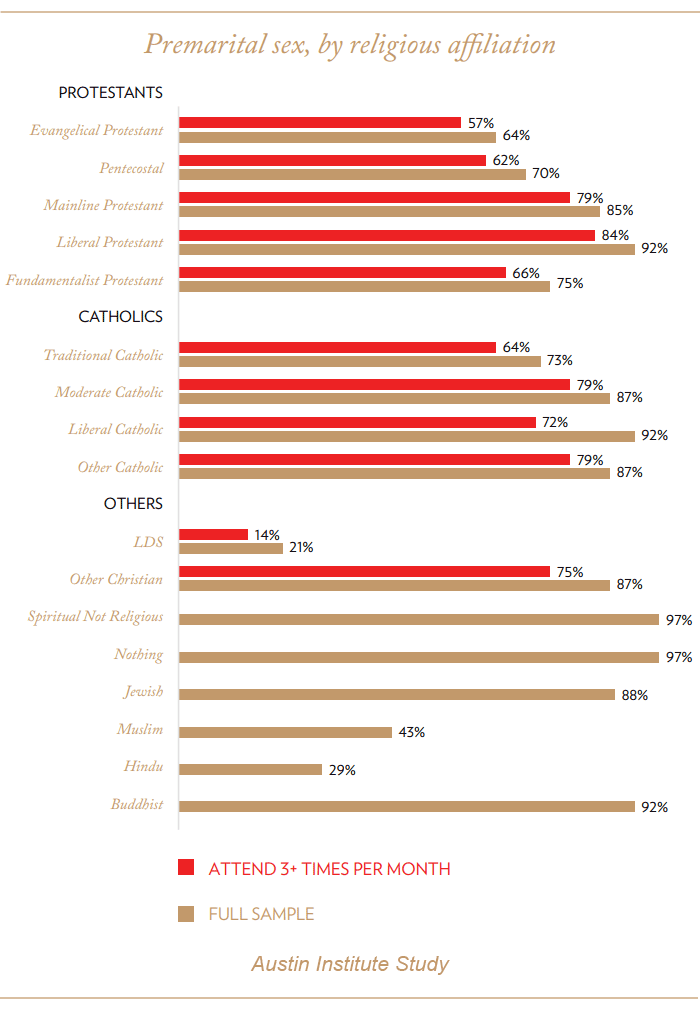If you’re inquiring about “how common is premarital sex,” statistical evidence suggests it’s pervasive in the U.S. and many other developed countries.
In this blog post, we’ll uncover the societal patterns and data that map out the current landscape of premarital sexual behaviors, offering an understanding of our world’s prevailing attitudes.
Understanding the Prevalence of Premarital Sex
Religion, age, country of origin, education, and the media all influence our society’s attitudes on whether or not it is okay to have sex outside of marriage. Defining premarital sex as sexual activity engaged in by individuals prior to marriage, research indicates that 75% of Americans had had premarital sex by the time they were 20 years old, and 95% had done it by 44 years of age.

The Impact of Religion on Premarital Sex
Religion plays a key role in shaping attitudes and behaviors toward premarital sex, especially in adolescents. Different religions have varying doctrines about premarital sex. For instance, in Christianity, premarital sex is commonly regarded as immoral and unBiblical, with a significant focus on maintaining sexual purity and waiting to have sex until it is within the institution of marriage.
Even more strictly, Islam unequivocally prohibits premarital sexual relations. Islam deems it not only immoral but also a punishable transgression against the rights of Allah and one’s own body. These religious doctrines and beliefs significantly influence the attitudes and behaviors of individuals toward premarital sex.

National Survey Insights
Insights into the prevalence of premarital sex are provided by the National Survey of Family Growth by the Centers for Disease Control and Prevention. By characterizing premarital sex as engaging in sexual intercourse before marriage, they reveal that by age 44, 89% of women and 90% of men have engaged in premarital sex, with 41% of women and 40% of men having done so by age 19.
Factors such as the increasing average age at marriage and the easy access to effective contraceptives, particularly among the youth, have influenced the prevalence of premarital sex. As people are getting married later in life, premarital sex is becoming more common, leading to increased discussions and studies about its implications.
The widespread occurrence of premarital sex provides a glimpse into the changing social and cultural landscape that has contributed to the prevalence of premarital sex.
Trends Over Time
Since 1954, studies have shown that the percentage of sexually active individuals who engage in premarital sexual activity increased by a small amount.
The main factors contributing to the slight increase in premarital sexual activity include the declining rates of marriage and shifting behavioral attitudes towards values such as honor, personal modesty, chastity, and respect for boundaries in relationships with the opposite sex, especially among unmarried adults.
Though the prevalence of premarital sex in the United States has remained relatively stable over the past several decades, there has been a growing trend of premarital sex in countries where marital sex has traditionally been considered the norm, such as India, Indonesia, and Iran. This indicates that the trend of premarital sex is not just confined to the U.S. but is a global phenomenon.
Global Perspectives
From a global perspective, it’s evident that attitudes towards premarital sex vary substantially. Some countries and cultures hold more conservative views, often influenced by traditional values and religious beliefs. However, in 10 out of 12 developed nations with available data, more than two-thirds of young individuals have engaged in sexual intercourse during their teenage years.
In stark contrast, the prevalence of premarital sex in developing countries is substantially lower, at approximately 10.8%, while in certain developed nations, it can exceed 80%. This discrepancy highlights the cultural differences and societal norms that influence sexual behavior across different geographical locations, such as being subjected to early marriage in countries like India.
Demographics and Premarital Sexual Behavior
Personal demographics shape not only our attitudes and behaviors but also our premarital sexual behavior. Engagement in premarital sex is a prevalent phenomenon among young adults, with the average age at first vaginal (sexual) intercourse for women and men at 17 years old.
As for gender, across the globe, males generally take the lead in initiating premarital sex and exhibit more permissive attitudes towards it when compared to females.
Understanding these demographic influences can provide insights into addressing the societal implications of premarital sex.
Age Range and Young Adults
Age is a demographic factor that has a significant impact on premarital sexual behavior. By the age of 19, approximately 40% of young people have engaged in premarital sex. The majority, or 62% of women and 52% of men, were “going steady” with their partner at the time they had sex with them, as opposed to just going out once in a while, having just met, or being just friends.
Gender Differences in Sexual Attitudes
In terms of attitudes towards premarital sex, gender plays a substantial role among male and female respondents. Men tend to self-report more permissive attitudes about casual sex compared to women, and they are more inclined to initiate sexual intercourse.
On the other hand, females often adhere to strong norms that dictate sexual behavior should take place within the confines of a committed relationship. Such gender differences in sexual attitudes underscore the complexity of the issue and the need for nuanced approaches in addressing premarital sex.
The Role of Education and Abstinence Programs
In trying to shape healthy and safe behaviors related to premarital sex, we’re not doing very well. Research shows that only 36% of comprehensive sex education programs caused moderate declines in pregnancy rates and in the rates of unprotected sex. For those programs that did decrease pregnancy, they only decreased teenage pregnancy rates by around 3%.
These programs vary in their approaches, with some focusing solely on promoting abstinence until marriage, while others provide comprehensive sex education that includes information about safe sex practices and the use of contraceptives like condoms.
We clearly need to do a better job of sex education. Still, the current programs at least provide individuals, particularly the youth, with the necessary knowledge and skills to make informed decisions about their sexual health.
Sex Education and Reproductive Health
We need better comprehensive sex education. Ideally, sex education would promote abstinence, but realize that teens historically have not listened and have had sex anyway. So, sex education should also promote safe sex practices to reduce teenage pregnancy and sexually transmitted disease rates. A good program would thoroughly cover topics such as:
-
Reproductive health
-
Sexual abstinence as an ideal
-
Safe sex practices for those who are going to do it anyway
-
Birth control methods
Evaluating Abstinence-Only Education
Abstinence-only education advocates abstaining from sexual activity until marriage. This type of education teaches that abstinence is the sole acceptable choice. Studies by the U.S. National Institutes of Health show that abstinence-only sex education is ineffective in postponing the initiation of sexual activity or reducing sexual risk behaviors among adolescents.
These same studies instead show that abstinence-only programs have the exact opposite of the intended result, likely increasing teenage pregnancies and births. This criticism seems to indicate that young adults will do what they want to do, despite what the adults teach them. And if they are going to have sex anyway, is it then unprotected because abstinence-only education fails to teach them about contraception and safe sex options?
Societal Attitudes and Media Influence
Perceptions of premarital sex are significantly shaped by societal attitudes and media influence. Cultural beliefs and attitudes frame premarital sex as a normal and beneficial aspect of life, which does not have negative implications for future marriage and family life.
From music, to movies to social media, media portrayals of premarital sex have become common, normalizing sexual behaviors before marriage and shaping more lenient societal norms and beliefs about these actions.
Shifts in Cultural Values
With time, cultural values have evolved to become more accepting of premarital sex. This shift reflects a generational change in beliefs about sex and sexuality. A Pew Research study found that people in the Muslim countries of Indonesia, Jordan, Pakistan, Palestine, Turkey, and Egypt overwhelmingly find premarital sex unacceptable. In stark contrast, approximately 90% of people in Germany, France, and Spain find it acceptable.
This heightened acceptance of premarital sex is attributed to:
-
Diminishing behavioral beliefs
-
The experience of falling in love
-
Sexual desire
-
Influences such as sex, current residence, pocket money, poverty, peer group, pornography, and the desire for pleasure
Media Portrayals of Sexuality
The media often portrays premarital sex as risk-free and rarely includes the associated responsibilities and risks.
Moreover, the portrayal of sexuality in the media has evolved over time, witnessing an increased prevalence of sexual talk and depictions of sexual behavior in televised media. This portrayal of sexuality and premarital sex in the media contributes to shaping societal norms and attitudes, making premarital sex more acceptable.
Consequences and Considerations of Premarital Sex
Even though premarital sex is common, we still need to think about the consequences of it. Research suggests that having multiple premarital sexual partners can undermine marital stability and increase the risk of divorce by 161%.
Moreover, engaging in premarital sex can lead to emotional implications, including feelings of regret and lower quality in marital relationships. These consequences highlight the need for thoughtful consideration and responsible practices when it comes to premarital sex.
Preventing Teen Pregnancy and STIs
When teens have sex outside of marriage, one primary consideration is the prevention of teen pregnancy and contracting sexually transmitted infections (STIs) when teens have multiple sexual partners. Our current sex education programs (including those that are abstinence-only) have failed, resulting in only a slight decrease in teen pregnancy rates.
The most efficient contraception methods for preventing teenage pregnancy are long-acting reversible contraception (LARC), such as intrauterine devices (IUDs) and hormonal implants. IUDs have been shown to be over 99% effective and can last for up to 10 years, depending on the type. There are also hormonal injections and a contraceptive patch that are good options.
Preventing STIs can be effectively achieved by consistently practicing safe sex, which involves the utilization of latex or polyurethane condoms during all types of sexual activities—vaginal, oral, or anal—and by choosing to abstain from sexual contact.
Emotional and Relational Implications
It is also important to consider the emotional and relational implications of premarital sex. Individuals, including unmarried women, who have had multiple sexual partners during their dating years are more likely to experience lower marital stability, reduced marital relationship quality, and higher divorce rates.
Understanding these implications can help individuals make more informed decisions about their sexual behavior.
The Legal Landscape and Premarital Sex
Across countries, there is wide variation in the legal landscape surrounding premarital sex. In some countries, premarital sex and cohabitation are partially criminalized, with penalties for those who engage in such behavior.
However, in other countries, the legal landscape is more progressive, recognizing and advocating for privacy rights and sexual freedom. This divergence in legal perspectives underscores the complexity of the issue and the need for continued dialogue and understanding.
Laws Criminalizing Premarital Sex
In countries such as Indonesia, Sudan, Malaysia, and Egypt, premarital sex is viewed as a criminal offense. The penalties for engaging in premarital sex in these countries can be severe. For example, under Sharia law, premarital sex and adultery can result in the accused being sentenced to death by stoning.
These laws are enforced through arrests and prosecutions, with the frequency of enforcement varying depending on the jurisdiction and the specific circumstances. The reasons for the criminalization of premarital sex in these countries often stem from religious or moral beliefs, societal norms, and cultural values.
Privacy Rights and Sexual Freedom
Whether premarital sex is okay or not okay, we are fortunate in the U.S. to have so many constitutional freedoms, including the freedom to have consensual sexual activities. Other countries, in contrast, emphasize privacy rights and sexual freedom among heterosexual partners. This freedom is not similarly extended to the LGBTQ+ community in numerous countries. There are at least 67 countries that criminalize same-sex relations and at least nine countries that criminalize expressions of gender that do not conform to traditional gender lines.
Premarital sex is a very real fact of life for many people. It transcends societies, cultures, religions, and legal frameworks. It’s an issue that affects us all, directly or indirectly. Through understanding the prevalence, influences, and implications of premarital sex, we can foster a more informed society that respects individual choices while promoting healthy sexual behavior.





